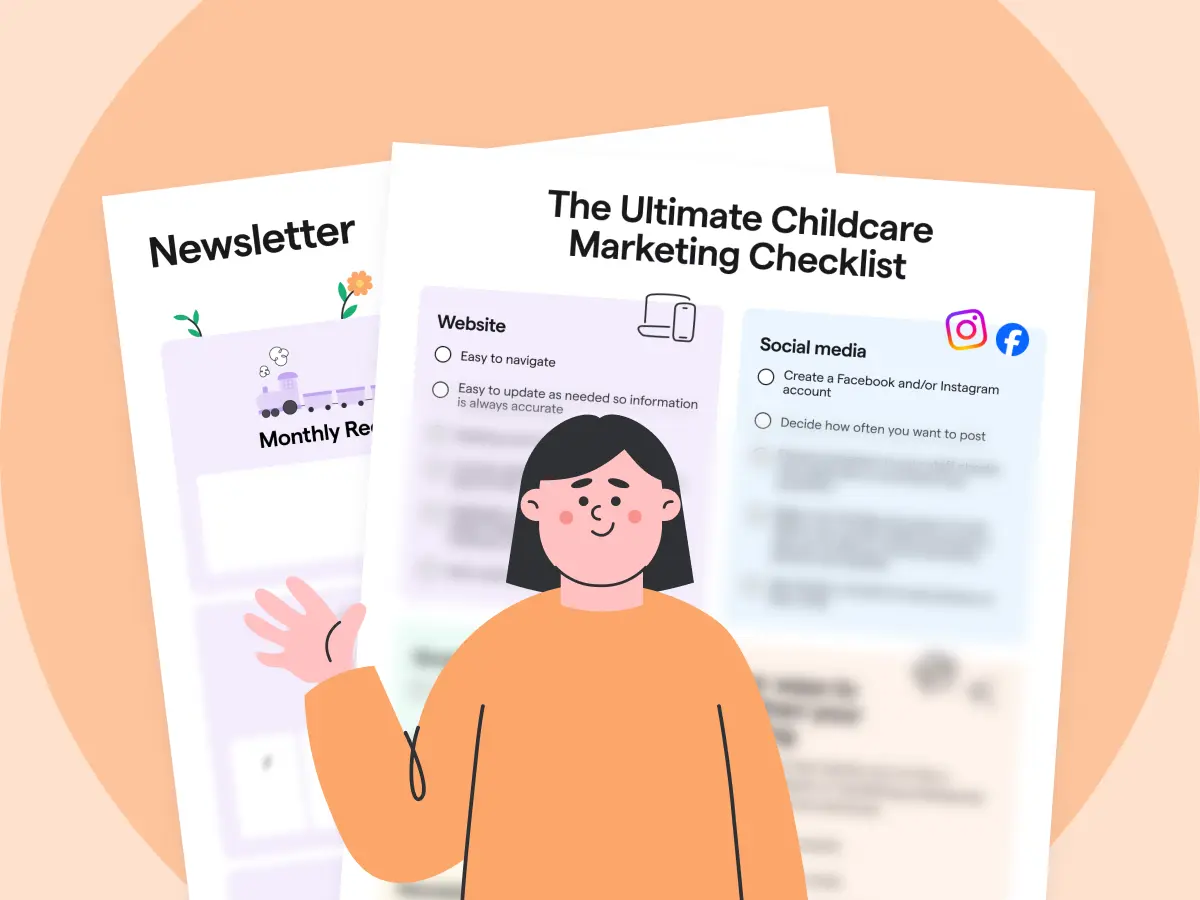settings
children
With Famly since
Child care and marketing. If you’re not used to seeing those terms together, you’re not alone.
Marketing seems so … big business, right? It feels like your child care setting ought to get by on reputation alone. And in a perfect world, that’d certainly be the case.
Unfortunately, that perfect world hasn't arrived yet. And in the meanwhile, early educators are under a lot of pressure — not least of which is the fact that it's getting especially difficult to keep your occupancy numbers where you want.
So what do we do about it?
Well, if you ask Michael Tasner, it’s time we talk more about child care marketing.
Michael has been working in child care marketing for 11 years. He’s the CEO of No Joke Marketing, and has worked with hundreds of early educatorsto help build their promotional efforts, and boost their occupancy numbers. As he sees it, all the stresses of the past few years have made child care marketing more and more important for the sector.
“We can’t rely on parent referrals like we used to. Now providers who never really had to spend much time on marketing have to understand how to do it,” he says.
In this article, we’ll explore some of the best tips for child care marketing. I’ll look at how you can get a clear picture of the perfect future customer for your setting, and then we’ll talk about the most effective ways to reach them.
But first, let’s start with that cynical question: Why bother with marketing?

The big ideas
Why does child care marketing matter in 2023?
In a sentence, child care marketing matters more than ever because we can no longer rely on the same sources for child care occupancy.
“It’s no longer an ‘if you build it, they will come’ sort of environment. You’ve got to be proactive in understanding who your customers are, and connecting with them,” Michael says.
Historically, child care settings’ best source of new customers has been parent referrals. But the sector is still reeling from the pandemic here, which put a damper on this source of new customers. And with parents struggling to pay for care, those trusty referrals are getting harder to come by. This is why Michael says providers need to get more proactive with marketing.
Granted, this is easier said than done. Especially when budgets are tight, finding the money for marketing might not seem like a priority. But as Michael sees it, child care marketing has got more and more to do with your bottom line. You might think of it as a return on investment, rather than a flat expense.
“A lot of child care providers are used to spending nothing on marketing. So if your budget is zero, anything is going to seem expensive,” Michael says. “But we’re getting to the point where if you don’t do any marketing, you’ll start losing new parents to the providers that are.”
How to find where your next customers are located
When Michael starts advising new clients on child care marketing, he starts by pulling up a map.
Looking at geography can be very telling. It helps you understand which areas your future customers might live in, and how far people are willing to drive to come to your setting.
Plus, you’ve already got the data you need to do this.
“Most of my customers are sitting on a gold mine of data,” Michael says. “They’ve already collected a lot of the information they need in what they’ve got about their current and past customers.”
A great place to start is by looking at your records, pulling the addresses of current and past customers, and plugging them all into a map. Once you’ve got them all charted, you can look for patterns:
- Are a lot of parents coming from one area?
- Are most of them very close to you?
- What’s the furthest distance from which people are coming to your setting?
As an average, Michael says, child care customers tend to come from within a 3- to 5-mile radius of your setting. But this can vary depending on where you are. In a big city, that radius might be as small as a quarter mile — and in rural areas, it could be 15 miles or more.
Knowing where your families come from is a good first step in building up your marketing efforts. It’ll help you understand where potential customers might be, and where you should target your marketing within your area.

What makes your child care unique?
You might have heard the abbreviation USP before. That stands for ‘unique selling point’.
Within child care marketing, it refers to something special about your setting that might affect where your customers come from, or how far they’re willing to travel for your care. Knowing your USPs might help give you a clue on how to target your marketing efforts.
So how does your setting compare to other providers in your area? Michael points to the following USPs as examples that might set you apart:
- Montessori programming
- A vegetarian or organic lunch program
- Bilingual care and team members
- Specializing in children with special needs
If you have some factor that sets your program apart, think about how that might affect where you find your customers. Would parents live in a certain areas, or frequent any local business? Would they read some specific publication, or be more likely to use a certain website or social media platform?
All of these factors can help shape how, when and where you connect with your ideal customers. But, as Michael says, you don’t need to have that unique factor.
“A lot of the time, the answer is no, and that’s alright. Sometimes there are just a lot of early care providers in your same area, so it’s hard to really be unique,” he says. “In that case, you’ve just got to out-market the competition. Invest more, spend more, put out more ads, get in front of people more strongly.”
Of course, depending on your setting’s size and budget, this can often be easier said than done. Still, any marketing is better than nothing — and there are plenty of ways to promote your setting that don’t cost a cent.
And if you'd like to learn more about USPs (and how to find one for yourself).
Parent surveys: understand who your customers are
You probably know the parents at your setting pretty well. But where does that knowledge come from? Likely through some back-and-forth texts, and quick conversations during morning drop-offs. When it comes to your marketing efforts, we can get strategic with this sort of knowledge.
If you can put all that parent knowledge down on paper, you’ll get a whole new picture of who connects with your child care setting.
The easiest way to do this is through parent surveys. With online platforms like Surveymonkey, you can send a quick questionnaire straight to parents’ inboxes. It’s a quick, simple and cost-free way to paint a picture of who to target with your child care marketing. Maybe every parent picked your setting for the same reason!
If you’re sending out one of these simple surveys, you’ll want to ask about what made your setting stand out to your customers. Here are some questions you might ask:
- What was the number one reason you decided to pick this setting?
- How was your first day, or first visit here? Did anything stick out, in a good or bad way?
- What does your child like best about their day when they’re at this setting?

Getting even more advanced with parent surveys
If you want an even sharper picture of who prefers your child care center, you can get more detailed with your parent surveys.
An in-depth survey can help you understand what type of people prefer your care, based on your existing enrollments. The thing is, you might need to sweeten the deal if you’re asking a lot of questions.
Michael recommends incentivizing survey respondents with a gift card, or entering respondents in a raffle. He’s found that a $20 gift card can get parents to spend 30 to 40 minutes answering a survey.
In that in-depth survey, here’s what you might try to learn about your parents:
- Age, and age of partner (if applicable)
- Number of children
- What local businesses or venues they visit most
- Which radio station they listen to the most
- Their favorite magazines and local publications
But wait, why would you need to know what radio stations your families listen to, or what magazines they read?
Fair question. It’s not actually about advertising on the airwaves — it’s because you can learn a lot from what that radio station knows about their listeners.
Special trick: What a media kit can do for you
Most every radio station and local publication has a media kit. It’s a collection of information about a media outlet’s audience, which is meant to help advertisers decide if that’s the right place to put an ad.
The thing is, anyone can access those media kits. Radio stations and publications often make them available on their website, or you could email or call them to request a copy.
Often, that media kit can give you a very sharp picture of a target audience. You might learn more about an average family size, average income, level of education, consumer habits, their values and preferences. You can use all that to help sharpen your marketing efforts.
So if your parent survey says that a lot of your families listen to a certain radio station, or read some magazine, go request their media kit. It’ll give you a high-resolution picture of who your target might be, and how you can best connect with them.

Where to focus your marketing efforts
So, you’ve got a picture of your ideal client, and now you’re ready to launch a marketing campaign and watch the enrollments come rolling in.
But what’s the most effective place to place an ad?
According to Michael, you’ll get the most bang for your buck by focusing your child care marketing budget on social media, local publications and partnerships. Here’s what he recommends most, and why:
Digital platforms for child care marketing
- Facebook – Michael recommends Facebook advertising for the vast majority of his clients, because of the level of personal detail you can control when you decide who sees your marketing. The sharper a picture you have of your ideal customer, the more directly you can reach them.
- Google Ads – Google’s advertising platform is flexible and wide-reaching — so marketing here means casting a wide net, digitally speaking.
- YouTube – If you can whip up a compelling video message, promoting your child care marketing through YouTube ads is an especially good way to reach younger parents.
Local platforms for child care marketing
- Businesses in your area – As Michael says, it can still be effective to place flyers and physical advertisements in popular local businesses, or even ask them about setting up referral partnerships. Coffee shops, toy stores, and anywhere else with lots of parents and children is a good pick.
- Local publications – If you’ve found out a lot of the parents at your center read a certain publication, that might be a good place to connect with more like-minded families.
How has child care marketing changed in 2023?
As Michael sees it, one of the biggest new shifts in child care marketing is the need to get out and chase down new customers. Waiting for the occasional referral to come in might not cut it anymore.
Scrolling past a Facebook ad might put your child care setting on a parent’s mind, but that deal is far from sealed. Michael says the key to good child care marketing is being persistent with your follow-up calls, once you’ve made that first impression with your marketing.
He knows this isn’t exactly the norm within the sector.
“The idea of marketing is a little scary to a lot of people in child care. Calling potential customers during business hours, sending text messages and emails, making that second follow-up phone call, it can feel aggressive,” he says. “But those leads you get from Facebook and Google advertising aren’t the same as parent referrals, who are basically pre-sold. You’ve really got to follow up with your child care marketing to see results.”
Especially when our budgets are particularly tight, marketing might not seem like the most important expense. But Michael says putting some funds and energy into marketing now could make the coming months easier.
“A lot of child care centers are scaling back right now, and taking their finger off the pulse. But if you’re doing that and other providers aren’t, you’ll risk losing out to them,” he says. “For marketing and boosting occupancy, now is really the time to double down and come out swinging.”
Free downloadable Early Childhood resources
Explore our library of longer-form books, guides and editable templates - all free to download.
Explore free resources









